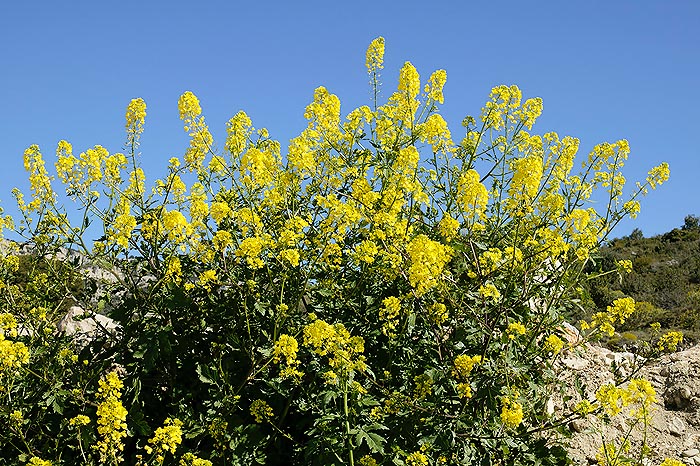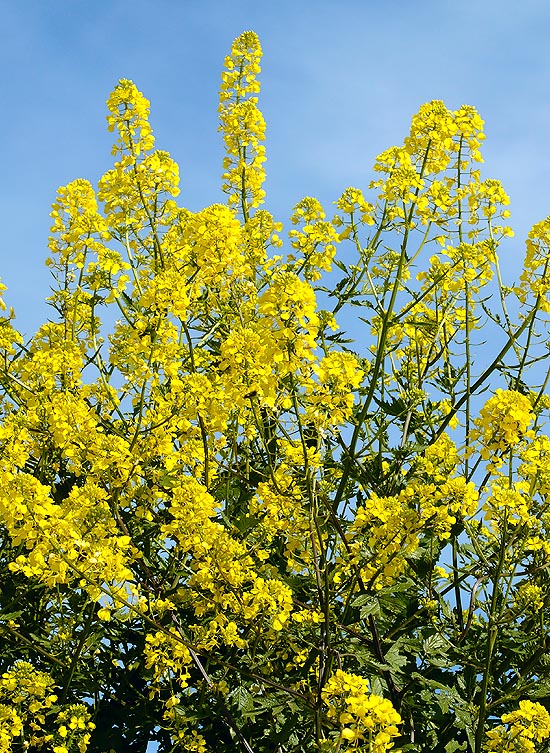Family : Brassicaceae

Text © Pietro Puccio

English translation by Mario Beltramini

The Sinapis alba is cultivated since remore ages in the Mediterranean area as medicinal and spice plant © Giuseppe Mazza
The name of the genus is the Latin name of the plant, “sinapis” = mustard; the Latin name of the species, “alba” = white, refers to the pale colour of its seeds.
Common names: yellow mustard, white mustard (English); moutarde blanche (French); senape bianca, senape gialla, luchettone, rapicello selvatico, ruchettone (Italian); mostarda-branca (Portuguese); mostaza blanca (Spanish); Weißer Senf (German).
The Sinapis alba L. (1753) is an annual herbaceous plant, with tap roots, about 1 m tall, with stems longitudinally furrowed, erect, ramified and hispid. The leaves, with a more or less hispid surface, are alternate, the inferior ones being petiolate, 5-15 cm long and 2-6 cm broad, palmate lobate, with 1-3 lobes per side, oblong and lanceolate, 1,5-2,5 cm long with indented margins; the terminal lobe, ovate, is usually much bigger than the lateral ones, up to 6 cm of length, with irregularly indented margins. The upper leaves, getting smaller progressively, on short or absent (sessile) petiole, are 2-4 cm long and have almost identical lobes with indented margins.
The inflorescences are racemes, long up to about 30 cm, carrying several flowers with 5 mm long and 1,5 mm broad sepals, stretched or retroflexed, of yellowish colour, and four obovate yellow petals, 8-12 mm long and 4-5 mm broad.
The fruit is a cylindrical siliqua slightly compressed, 2-4 cm long and about 0,4 cm broad, thickly covered by short whitish bristles, with flat terminal segment, seedless, 1,5-2,5 cm long, straight or curved, with pointed apex; the fruit contains 1-3 (5) globular seeds of 2-3 mm of diameter of pale brown colour and finely grained surface. It reproduces by seed in spring, directly in place, with blossoming which starts after 2-3 months.

This showy species is 1 m tall with 30 cm inflorescences © Giuseppe Mazza
From the Mediterranean countries, its cultivation has progressively spread to north Europe, Asia and North America. Due to the short lasting of its vegetative cycle, it may be cultivated in almost all climates, it is not demanding as soil, even if it prefers the clayey-calcareous ones and apart from possible watering after sowing and till when it germinates, it may be almost ignored.
For the production of the seeds, the harvesting is done before they are completely ripe, because they might be lost when the siliqua opens. After the collection of the seeds, the plants are utilized as fodder.
In some countries it is utilized also as vegetable, to be eaten raw or cooked, and for this purpose it is sown repeatedly at intervals of about one month and is harvested for getting tender leaves with a delicate taste.
The seeds contain the 25% to 45% of oil, utilized in the alimentary, cosmetic, pharmaceutical and as lubricating industries, but the most important utilization of the seeds is for the production of the flour utilized, by itself only or variously mixed with the one gotten from the seeds of the black mustard (Brassica nigra), for preparing together with other ingredients (vinegar, wine, beer, etc.), the different types of mustard, different from region to region, or other spicy sauces.
The substance giving the typical taste and smell to the white mustard is not really present in the seeds, but comes from a glucoside (sinalbin), crystalline substance which, in presence of water, is decomposed by an enzyme, contained in the same seed (myrosin), in an essential oil with pungent taste due to the presence of a sulphur compound (isothiocyanate of para-hydroxybenzyl), but with a less acrid taste and smell than that obtained from the seeds of the black mustard (Brassica nigra), due to a similar glucoside (sinagrin). The mustard, besides giving the food a particular taste, in small amounts stimulates the gastric secretion, but may cause irritation to the digestive system in particular situations and in high dosage has emetic and highly irritating effect.
Completely different is the Italian mustard, done with canned fruit together with seeds of mustard, in various dosages and with other ingredients depending on the local traditions. We remind also, finally, that the seeds of Sinapis alba, and of Brassica nigra, as well as all their derivates, contain allergenic substances.
Synonyms: Raphanus albus (L.) Crantz (1769); Brassica hirta Moench (1802); Sinapis foliosa Willd. (1809); Bonannia officinalis C.Presl (1826); Rhamphospermum album (L.) Andrz. ex Rchb. (1828); Napus leucosinapsis K.F.Schimp. & Spenn. (1829); Eruca alba (L.) Noulet (1837); Leucosinapis alba (L.) Spach (1838); Brassica alba (L.) Rabenh. (1839); Crucifera lampsana E.H.L.Krause (1902); Brassica foliosa (Willd.) Samp. (1947).
→ For general notions about BRASSICACEAE please click here.
→ To appreciate the biodiversity within the BRASSICACEAE family please click here.
